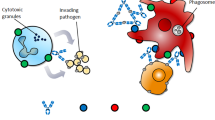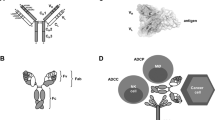Abstract
Antibody fragments can be isolated rapidly using techniques such as phage display and can be expressed to high levels in microbial systems. However, to date such antibody fragments have been of limited use for many therapeutic applications because they are rapidly cleared from the body. We present a strategy for the site-specific chemical modification of antibody fragments with polyethylene glycol, which results in the production of antibody fragments with long in vivo half-lives and full retention of antigen-binding properties. This technology should allow more rapid and economical production of therapeutic antibodies for chronic disease therapy.
This is a preview of subscription content, access via your institution
Access options
Subscribe to this journal
Receive 12 print issues and online access
$209.00 per year
only $17.42 per issue
Buy this article
- Purchase on Springer Link
- Instant access to full article PDF
Prices may be subject to local taxes which are calculated during checkout





Similar content being viewed by others
References
Vaughan, T.J., Osbourn, J.K. & Tempest, P.R. Human antibodies by design. Nat. Biotechnol. 16, 535–539 (1998).
Dickman, S. Antibodies stage a comeback in cancer treatment. Science 280, 1196–1197 (1998).
Elliott, M.J. et al. Randomised double-blind comparison of chimeric monoclonal antibody to tumor necrosis factor α (cA2) versus placebo in rheumatoid arthritis. Lancet 344, 1105–1110 (1994).
Rankin, E.C.C. et al. The therapeutic effects of an engineered human anti-tumour necrosis factor alpha antibody (CDP571) in rheumatoid arthritis. Br. J. Rheumatol. 34, 334–342 (1995).
Bebbington, C.R. et al. High-level expression of a recombinant antibody from myeloma cells using a glutamine synthetase gene as an amplifiable marker. Bio/Technology. 10, 169–175 (1992).
Skerra, A. & Pluckthun, A. Assembly of a functional immunoglobulin Fv fragment in Escherichia coli. Science 240, 1038–1041 (1988).
Carter, P. et al. High level Escherichia coli expression and production of a bivalent humanized antibody fragment. Bio/Technology 10, 163–167 (1992).
King, D.J. et al. Tumor localisation of engineered antibody fragments. Antibody Immunoconjugates and Radiopharmaceuticals 5, 159–170 (1992).
King, D.J. et al. Improved tumor targeting with chemically cross-linked recombinant antibody fragments. Cancer Res. 54, 6176–6185 (1994).
Monfardini, C. & Veronese, F.M. Stabilization of substances in circulation. Bioconjug. Chem 9, 418–450 (1998).
Kitamura, K. et al. Chemical engineering of the monoclonal antibody A7 by polyethylene glycol for targeting cancer chemotherapy. Cancer Res. 51, 4310–4315 (1991).
Pedley, R.B. et al. The potential for enhanced tumour localisation by poly(ethylene glycol) modification of anti-CEA antibody. Br. J. Cancer 70, 1126–1130 (1994).
Horn, U. et al. High volumetric yields of functional dimeric miniantibodies in Escherichia coli using an optimised expression vector and high cell density fermentation under non-limited growth conditions Appl. Microbiol. Biotechnol. 46, 524–532 (1996).
Zeitlin, L. et al. A humanized monoclonal antibody produced in transgenic plants for immunoprotection of the vagina against genital herpes Nat. Biotechnol. 16, 1361–1364 (1998).
Pen, J. in Transgenic plants: a production system for industrial and pharmaceutical proteins (eds Owens, M.R.L. & Pen, J.) 149–167 (John Wiley, New York; 1996).
Humphreys, D.P. et al. F(ab´)2 molecules made from Escherichia coli produced Fab' with hinge sequences conferring increased serum survival in an animal model. J. Immunol. Methods 217, 1–10 (1998).
Author information
Authors and Affiliations
Corresponding author
Rights and permissions
About this article
Cite this article
Chapman, A., Antoniw, P., Spitali, M. et al. Therapeutic antibody fragments with prolonged in vivo half-lives. Nat Biotechnol 17, 780–783 (1999). https://doi.org/10.1038/11717
Received:
Accepted:
Issue Date:
DOI: https://doi.org/10.1038/11717
This article is cited by
-
Maleimide–thiol adducts stabilized through stretching
Nature Chemistry (2019)
-
Potent and conditional redirected T cell killing of tumor cells using Half DVD-Ig
Protein & Cell (2018)
-
99mTc-labelled S-HYNIC certolizumab pegol in rheumatoid arthritis and spondyloarthritis patients: a biodistribution and dosimetry study
EJNMMI Research (2016)
-
A plug-and-play approach to antibody-based therapeutics via a chemoselective dual click strategy
Nature Communications (2015)
-
Homogeneous antibody fragment conjugation by disulfide bridging introduces ‘spinostics’
Scientific Reports (2013)



